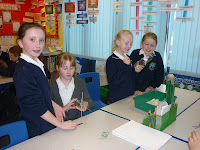Our first session started with a Y4 class and later a Y5 class with George introducing Leigh Ornithological Society and explaining what the Society is and does and why we call it the L.O.S. (most of us can't even say Ornithological never mind spell it!). George then went on to tell the children why we're visiting schools, especially at this time of year, with details of how we call all help the birds in our gardens, parks and schools.
 |
| Getting started |
 |
| Making the bottle feeder |
Then it was time for the main activity which Brian explained and demonstrated very carefully and clearly to each of the classes.
The Y4 class made hanging seed feeders from a recycled plastic bottle by inserting two thin garden canes at right-angles for perches, poking holes around the middle of the bottle through which the birds can eat the seed and then threading some garden wire through the top to hang it up.
 |
| A completed fatball feeder |
The fatball was then placed inside with the netting removed so that the birds don't get trapped. This simple feeder is actually one of the quickest and most effective of all the ones we make.
 |
| Martyn explaining bird food |
After this Martyn described and demonstrated some of the best types of bird food to use in and around the feeders at home and in school. This included sunflower hearts, black sunflower seeds, nyger seed, fatballs, peanuts and monkey nuts, mealworms as well as mixed seed.
A tub of each type of food was shown to the children who were very interested in the different sizes, shapes and colours of each.
This section was completed by briefly mentioning that some birds prefer to eat off the ground or bird tables, whereas others eat by hanging from tree branches. More is done on this in the next session.
 |
| Filling the feeder with seed |
Finally the pupils were asked to design a new logo for our Young Birders' Club and told that it was a competition with a bird-related prize for the winner. But perhaps more importantly, the winning design will be used on the LOSYBC website and any other documents we produce.
Our second visit to St. Richard's was focused on bird identification. The main activity was to build a rotating Bird ID Dial and then use it to identify some birds from photographs.
 |
| Brian's demonstration |
 |
| Carefully, accurately, meticulously! |
After the demonstration the children worked in pairs to cut out the dial's two cardboard discs and then fasten them together with a split pin fastener.
When they had finished, Martyn went to explain that some birds feed mainly on the ground and other mainly by hanging from branches, although they both may sometimes do the opposite when food is short.
After a brief outline of many ground feeding birds, he described two of them in detail, the Blackbird and Chaffinch, with large colour diagrams projected on the whiteboard and then finished off with the songs that each bird makes. Brian then did the same for two hanging feeder birds, the Blue Tit and Goldfinch. The class really enjoyed seeing the drawings and hearing the different sounds
 |
| Hard at work on the bird quiz |
The second quiz was a little harder, because only parts of the birds were shown in the photographs. A few pupils even went on to do a third quiz which was much harder than the first two.
The children all worked very hard on these quizzes and many got all the answers correct, so well done to all of you!
 |
| Hanging the feeders |
 Risking life and limb, Martyn stood on the steps to hang up a group of four feeders outside the Y4 classroom so that it could be seen from their windows - the same was also done with the Y5 class. However, as it was quite cold and windy, it wasn't surprising that we didn't stay outside for very long!
Risking life and limb, Martyn stood on the steps to hang up a group of four feeders outside the Y4 classroom so that it could be seen from their windows - the same was also done with the Y5 class. However, as it was quite cold and windy, it wasn't surprising that we didn't stay outside for very long!It was a pleasure to visit St. Richard's because all the pupils and staff (Mrs King, Ms. McGhee, Ms. Cunningham and the Office Staff) were very welcoming and enthusiastic. We hope to go back again sometime to do a session on recording the birds we can see either on the feeders, or perhaps on a short fieldtrip somewhere.
Martyn Jones
